10 home studio sound cards and audio interfaces for professional voice-over recordings
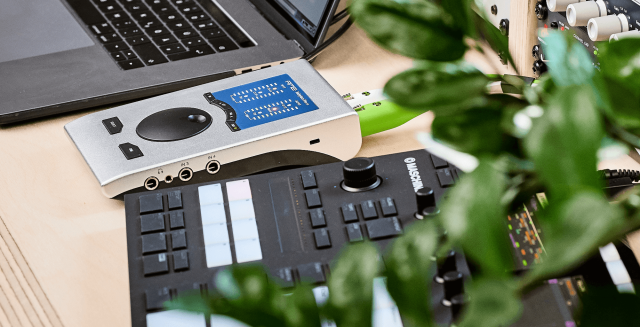
In this article, we delve into the top sound cards for your home studio, ideal for voice-over work and professional applications.
Much like your headphones, a sound card plays a crucial role in achieving high-quality sound recordings. Both your microphones and sound card hold equal weight in their contribution to the final output; if either falls short, achieving optimal sound quality becomes an unattainable goal.
Discover the sound cards used by the VoiceProductions team, along with our recommended picks across various price ranges. We'll guide you through a handpicked collection of top-tier sound cards and audio interfaces tailored for professionals.
Here's our list of the best sound cards and audio interfaces for professional voice over recordings:
- RME Babyface PRO: Used by myself and everyone else in the VoiceProductions team, including Jimmy, Bernard and Aurora. A very good card, though on the expensive side. Difficult to install, not great for beginners.
- Scarlet Focusrite: A good card for beginners, plug and play. Not without issues, as there's limited tweakability. There's now software for additional routing options, but it's not all-encompassing. Often used for singing or rap in small studios. Quite affordable, but if you're investing in a new mic, it might be worth upgrading this too.
- Behringer UMC 202HD: An affordable option with many possibilities. Not the warmest sound but good for starters.
- Universal Audio Apollo Solo / Twin: A wonderful card, expensive but not prohibitively so. Beautiful sound and lots of control.
- SSL 2: Not too expensive, very solid for what it does. Comparable to a Ford - well-made but not winning any F1 races.
- Audient ID Series (e.g., ID 4): Very well-made, beautiful sound. Easy to work with.
- Tascam: Has been making recorders for a long time. Generally okay, though models like HN, H2N, H4N, and H6N can introduce noise when plugging in an external mix due to insufficient grounding. Not the best option for VO.
- DBX 286: Known from large studios, it's a strip so it needs to be built into a rack. Works best in combination with other equipment in a strip. Very good, not easy for a beginner.
- M-Audio: Known for affordable cards. Easy to use but doesn’t always offer a deep, warm sound. Suitable if you don't need that, for example, with a high female voice.
- Apogee Duet 3: An expensive card with a very nice sound. Apogee has a range of equipment, of which this might offer the best price-quality ratio.
Essential insights before choosing your new sound card
The sound card is as crucial as the microphone. If either is subpar, you'll inevitably end up with poor results. When it comes to sound cards, bigger often does mean better. While this isn't always the case with microphones, it's almost a certainty with sound cards. A card under 100 euros will never deliver the same quality as one costing several hundred euros. Think of it this way: if the microphone is the ink, then the sound card is the gloss. The card adds warmth, color, and depth to your recordings.
Watch out for USB mics. The sound card is built into the microphone, making it so small that the conversion from analog to digital is rarely satisfactory. Good for personal use, not for professionals.
Newer isn't always better. Sound cards can remain effective for a long time. I know professional recording studios using sound cards from the 70s that still sound amazing. So, a second-hand card could be a viable option if you're on a tight budget.
Sound card functions to keep in mind
When looking for a professional sound card to record audio, understanding certain functions and terms can help you make an informed decision. Here’s a rundown of essential features and terminology.
Bit Depth
This determines the resolution of your recording, affecting the dynamic range and noise floor. A bit depth of 24 bits is standard for professional recordings.
Sample Rate
This is the number of samples of audio carried per second, measured in Hz or kHz. Higher sample rates capture more detail. For voice-overs, 44.1 kHz or 48 kHz are commonly used, but some professionals prefer 96 kHz for its increased clarity.
Latency
The delay between input into the microphone and output from the sound card. Low latency is crucial for real-time monitoring without noticeable delay. In voice-over work, where timing and delivery are everything, high latency can disrupt the flow of recording, making it difficult to sync voice-overs with video or other audio elements. Factors affecting latency include the audio interface's drivers, the computer's processing capabilities, and settings within your recording software.
To minimize latency, it's essential to choose an audio interface with robust, low-latency drivers that are compatible with your operating system and recording software. Utilizing drivers like ASIO (for Windows) or Core Audio (for Mac) and adjusting buffer sizes in your recording software can help achieve a balance between low latency and optimal performance.
Inputs/Outputs (I/O)
The number and type of inputs and outputs determine how many devices you can connect. For voice-overs, at least one high-quality microphone preamp input is essential. Look for XLR inputs for professional microphones.
Phantom Power (48V)
All condenser microphones require an external power supply to operate. Ensure your sound card provides 48V power if you use such a microphone.
Dynamic Range
The difference in volume between the quietest and the loudest sound the sound card can process without distortion. A higher dynamic range is better, with professional cards typically offering over 100 dB.
Signal-to-Noise Ratio (SNR)
This measures the level of the desired signal to the level of background noise. Higher ratios mean less background noise.
Total Harmonic Distortion (THD)
A low THD is crucial for clean, uncolored audio. It measures the sound card’s fidelity to the original audio.
Digital Signal Processing (DSP)
Some sound cards include built-in effects or processing, which can be useful for voice-over work. However, a pure, unprocessed signal path is often preferred for maximum flexibility in post-production.
Direct Monitoring
Direct monitoring allows you to hear your voice directly from the audio interface, bypassing the computer's processing. This feature is crucial for voice-over artists, as it enables real-time monitoring of your performance without the distraction of delay. Direct monitoring provides immediate feedback, essential for maintaining the natural flow and ensuring precise timing in voice-over work.
Most contemporary audio interfaces include a direct monitoring feature, accessible via a hardware switch or software control. Engaging direct monitoring eliminates perceptible latency, offering a seamless recording experience that allows you to concentrate on your performance rather than technical issues.
Now let's dive into the details of the audio interfaces and sound cards on our list
RME Babyface PRO FS Audio Interface
The RME Babyface PRO FS stands as a pinnacle of audio interface technology, embodying RME's commitment to superior craftsmanship in both audio circuits and driver development. This interface is not just a tool but a gateway to capturing sound with unmatched clarity and precision. Exactly why we use it. Priced around €750.
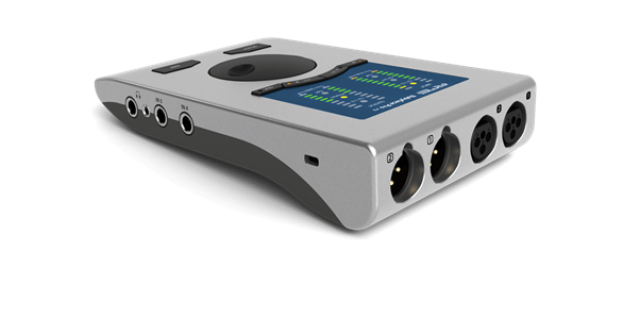
Why It's on the List:
- Exceptional Sound Quality: Users consistently praise its extreme fidelity, with tight low ends, transparent mids, and crisp, clear high-ends. It's built to deliver the stellar sound quality RME products are known for.
- Robust Build Quality: Crafted from a block of aluminum, it offers durability and reliability, ensuring it withstands the rigors of professional use.
- Low Latency: With a very stable ASIO driver from RME, it provides low latency crucial for real-time monitoring and seamless recording sessions.
- Versatile Connectivity: Equipped with XLR mic/line inputs, headphone outputs, ADAT I/O, and MIDI I/O, it supports a wide range of recording needs.
- Phantom Power: Each of its digitally controlled preamps offers switchable 48V phantom power, accommodating a variety of condenser microphones.
- High Dynamic Range and SNR: It boasts an improved signal-to-noise ratio and dynamic range, ensuring pristine audio capture and playback.
- Ease of Use: Despite its advanced features, users find the interface intuitive, with TotalMix FX software providing flexible mixing and routing capabilities.
Key Specifications:
- Bit Depth: Offers up to 24-bit resolution for professional-grade recordings.
- Sample Rate: Supports sample rates from 44.1 kHz up to 192 kHz, capturing every detail of the audio.
- Inputs/Outputs: 2 XLR mic/line inputs, 2 headphone outputs, ADAT I/O, and MIDI I/O cater to a broad spectrum of recording setups.
- Phantom Power: 48V phantom power available for both preamps.
- Dynamic Range: Enhanced dynamic range and signal-to-noise ratio for noise-free recordings.
- Latency: Further reduced latency with new ADCs, ensuring quick response times.
- Digital Signal Processing: TotalMix FX offers real-time mixing and routing, plus DSP effects like EQ, reverb, and delay.
User Reviews:
Professionals and enthusiasts like ourselves have lauded the Babyface PRO FS for its sound quality, reliability, and comprehensive feature set. Whether for music production, voice-overs, or any professional audio task, it delivers exceptional performance. Users particularly appreciate its robust build, low latency, and the flexibility offered by TotalMix FX. While it requires some initial setup, especially for those new to RME's ecosystem, the effort is well rewarded with unparalleled audio quality and control.
Focusrite Scarlett 2i2 (4th Generation)
The Focusrite Scarlett 2i2, a winner of the 2024 Sound On Sound award for the best audio interface, is celebrated for its studio-quality 2-in, 2-out interface, remastered for artists. It's renowned for its ultra-low-noise mic pres, high-quality line inputs, and studio-grade converters, offering a dynamic range that rivals professional studios. Priced around €195.
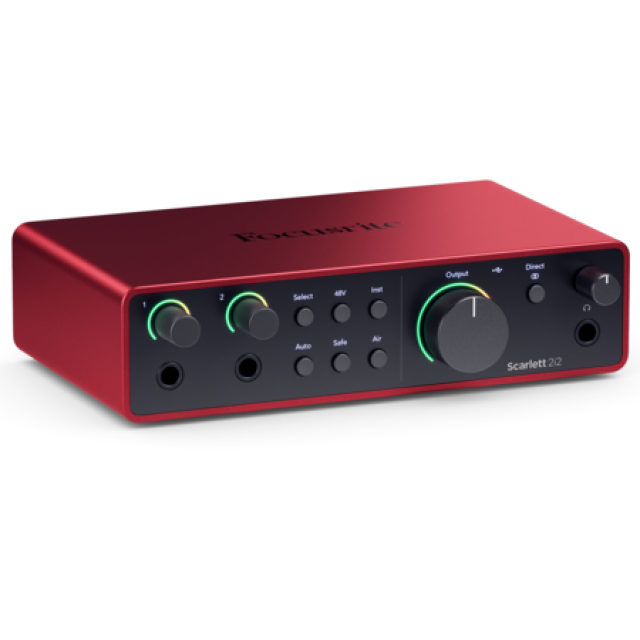
Why It's on the List:
- Award-Winning Quality: Recognized for its superior audio interface, ensuring trust and reliability in its performance.
- Ultra-Low-Noise Preamps: Features two of the most detailed, ultra-low-noise preamps, providing clarity and detail in recordings.
- High Dynamic Range: Boasts a 120dB dynamic range, ensuring recordings are clear and free from unwanted noise.
- Innovative Features: Auto Gain and Clip Safe functionalities prevent clipping and maintain optimal levels, ensuring you never lose a take.
- Air Mode: Adds presence and harmonic drive, emulating the big console sound, ideal for voice-overs.
- Comprehensive Software Bundle: Includes Ableton Live Lite, Pro Tools Artist, and the Hitmaker Expansion bundle, offering a range of tools for recording, producing, and releasing tracks.
Key Specifications:
- Bit Depth: 24-bit resolution for professional-grade recordings.
- Sample Rate: Supports up to 192 kHz, capturing every detail in your recordings.
- Latency: Features low latency for real-time monitoring, enhanced by its USB 2.0 connectivity.
- Inputs/Outputs: Equipped with 2 microphone preamps with phantom power, 2 instrument inputs, and 2 line inputs, plus 2 line outputs and a headphone output.
- Phantom Power: Yes, enabling use with condenser microphones.
- Dynamic Range: 120dB for line outputs, ensuring a wide volume range without distortion.
- Signal-to-Noise Ratio (SNR): 116dB for microphone inputs and 115.5dB for line inputs, indicating minimal background noise.
- Total Harmonic Distortion (THD): -100dB for microphone and line inputs, ensuring clean, uncolored audio.
User Reviews:
The Scarlett 2i2 is praised for its brutal honesty and detailed sound, perfect for high and tight low-end recordings. Users are particularly satisfied with its build quality, ease of use, and the comprehensive software bundle that comes with it. The interface’s ability to handle levels automatically and its provision of a clear, detailed sound make it a favorite among beginners and professionals alike. Its reliability and the support provided by Focusrite further cement its position as a go-to audio interface for voice-over recordings and beyond.
Behringer U-PHORIA UM2 Audio Interface
The Behringer U-PHORIA UM2 stands as a budget-friendly yet high-quality audio interface, offering a 2x2 USB interface for microphones and instruments. It's recognized for its affordability and robust features, making it a popular choice among beginners and semi-professional voice-over artists. Priced around €59.
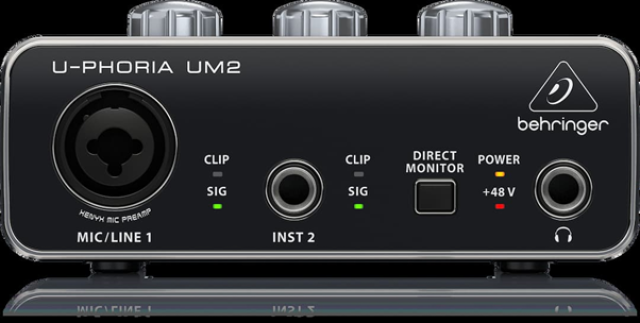
Why It's on the List:
- Affordable Quality: Offers professional audio quality at an entry-level price, making it accessible for beginners and semi-professionals.
- Midas Mic Preamplifiers: Features state-of-the-art, Midas-designed mic preamps with +48 V phantom power, ensuring clear and detailed recordings.
- High-Resolution Audio: With a 24-Bit/192 kHz resolution, it provides high-quality audio suitable for professional recordings.
- Ultra-Low Latency: Streams 2 inputs / 2 outputs with ultra-low latency, supporting both Mac OS X and Windows XP or higher.
- Direct Monitoring: Zero-latency direct monitoring allows for clear performance experience without delay or lag, enhancing recording quality.
- Robust Build: The metal chassis is "built-like-a-tank," ensuring durability and reliability for long-term use.
Key Specifications:
- Bit Depth: 24-Bit resolution for detailed and dynamic recordings.
- Sample Rate: Up to 192 kHz, capturing the full spectrum of sound with clarity.
- Latency: Ultra-low latency performance for real-time monitoring.
- Inputs/Outputs: 2 combination XLR/TRS inputs for microphones and instruments, along with 2 outputs and a headphone output.
- Phantom Power: +48 V phantom power for condenser microphones.
- Dynamic Range: Offers a dynamic range that competes with more expensive interfaces, ensuring clear recordings without noise.
- Signal-to-Noise Ratio (SNR): High SNR for clean audio capture, minimizing background noise.
- Total Harmonic Distortion (THD): Low THD for pure and uncolored audio output.
User Reviews:
The Behringer U-PHORIA UM2 receives mixed reviews, with many users praising its value for money, ease of use, and the quality of recordings it can produce. However, some users note issues with noise or interference, particularly when recording at higher gains. Despite this, it remains a recommended choice for those starting in music production or voice-over work, offering a solid foundation to learn and grow without a significant financial investment.
Overall, the Behringer U-PHORIA UM2 is celebrated for its affordability, making it an ideal entry-level interface for beginners and semi-professionals in voice-over and music production. Its combination of quality preamps, high-resolution audio, and robust build quality positions it as a reliable choice for those seeking to make quality recordings on a budget.
Universal Audio Apollo Twin Solo
The Universal Audio Apollo Twin Solo sets a new benchmark for desktop music production with its leading-edge sound resolution and real-time UAD processing. This 2x6 Mac Thunderbolt interface allows for near-zero millisecond latency recording with the full range of UAD powered Plugins, blending analog tones with smart features seamlessly. Priced around €475.
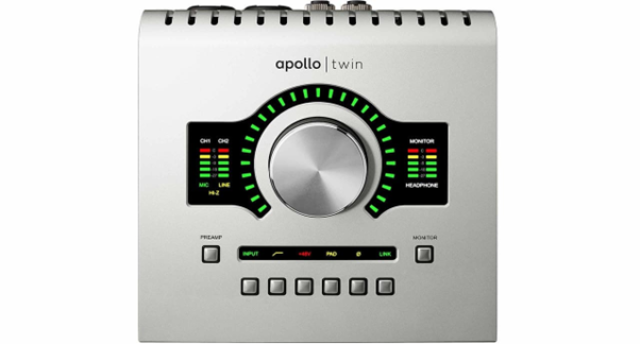
Why It's on the List:
- High-Resolution Audio: Offers world-class 24-bit/192kHz audio conversion, delivering sound with exceptional clarity.
- Real-Time UAD Processing: Enables the use of vintage compressors, EQs, tape machines, and guitar amp plug-ins with low latency.
- Unison Technology: Apollo Twin's mic preamps feature Unison technology, providing stunning models of classic mic preamps through the UA 610-B Tube Preamp plugin.
- Thunderbolt Connectivity: Provides super-fast PCIe audio drivers for high speed and low latency on all Thunderbolt-equipped Macs, significantly faster than FireWire 800.
- Premium Build Quality: Uncompromising analog design, superior components, and premium construction ensure durability and reliability.
Key Specifications:
- Bit Depth: 24-Bit resolution for detailed and dynamic recordings.
- Sample Rate: Up to 192 kHz, capturing the full spectrum of sound with clarity.
- Latency: Near-zero latency performance for real-time monitoring and recording through UAD plugins.
- Inputs/Outputs: Equipped with 2 combination XLR/TRS inputs for microphones and instruments, along with 2 line outputs and a dedicated headphone output.
- Phantom Power: +48 V phantom power for condenser microphones, available on both mic preamps.
- Dynamic Range: Offers a dynamic range that competes with more expensive interfaces, ensuring clear recordings without noise.
- Signal-to-Noise Ratio (SNR): High SNR for clean audio capture, minimizing background noise.
- Total Harmonic Distortion (THD): Low THD for pure and uncolored audio output, maintaining the integrity of the original signal.
User Reviews:
The Universal Audio Apollo Twin Solo is highly praised for its pristine audio quality, robust build, and the unique ability to use UAD plugins with near-zero latency. Users appreciate the Unison technology for its authentic emulation of classic preamps, enhancing vocal and instrument recordings significantly. The Thunderbolt connectivity is noted for its reliability and speed, allowing for a smooth and efficient workflow. While the interface is on the pricier side, users consider it a worthwhile investment for its performance and the quality of recordings it produces.
In summary, the Universal Audio Apollo Twin Solo is a top choice for professionals and serious enthusiasts in voice-over and music production, offering unparalleled sound quality, real-time processing capabilities, and a solid build. Its advanced features and compatibility with Thunderbolt-equipped Macs make it a versatile and powerful addition to any studio setup.
Solid State Logic SSL 2
The Solid State Logic SSL 2 brings the legendary sound quality and innovative design of SSL's 4000 series consoles into a compact, easy-to-use audio interface that's perfect for home studios, content creators, and mobile producers. With its real analogue enhancement inspired by the SSL 4000 series, the SSL 2 offers a unique combination of professional studio quality and portability. Priced around €195.
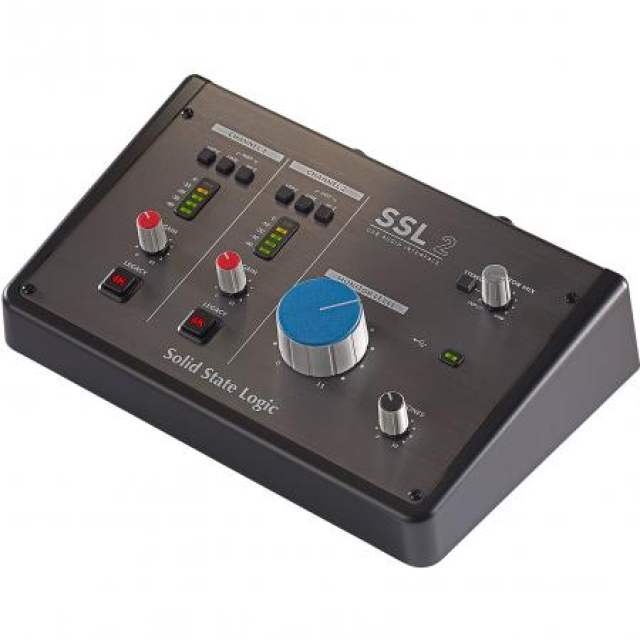
Why It's on the List:
- Legacy 4K Analogue Enhancement: Inspired by the SSL 4000 series console, the Legacy 4K feature adds a high-frequency EQ boost and subtle harmonic distortion to give your recordings that classic SSL sound.
- Class-Leading Preamps: Two beautifully detailed mic preamps capture every nuance with exceptional noise performance and a superior gain range.
- Professional Studio Quality: Uses industry-grade components found in larger SSL consoles, ensuring the same high-quality sound in a personal workspace.
- Content Creation Friendly: Equipped with all the tools needed for high-quality podcasting, live streaming, and online performances, including built-in Loopback functionality.
Key Specifications:
- Bit Depth: Offers high-resolution audio capture with support for up to 24-bit depth.
- Sample Rate: Supports a wide range of sample rates from 44.1 kHz up to 192 kHz, ensuring compatibility with professional recording standards.
- Latency: Features low-latency monitoring capabilities, allowing for real-time performance and monitoring.
- Inputs/Outputs: Includes 2 combination XLR/TRS mic/line/instrument inputs, monitor outputs with exceptional dynamic range, and a high-current headphone output for detailed monitoring.
- Phantom Power: +48 V phantom power supports condenser microphones for high-quality vocal recordings.
- Dynamic Range: Monitor outputs boast a dynamic range of 112 dB, and headphone outputs offer a dynamic range of 111 dB, ensuring clear and detailed sound reproduction.
- Signal-to-Noise Ratio (SNR): Provides an exceptionally low noise floor, with a -130.5 dBu EIN on the mic preamps, ensuring pristine audio capture.
- Total Harmonic Distortion (THD): Designed to inject a controlled amount of harmonic distortion for that classic SSL edge without compromising audio clarity.
User Reviews:
Music Radar praises the SSL 2 for its fantastic sound, high-quality components, and performance that outperforms competitors in its price range. Users highlight the Legacy 4K feature for adding life to dull recordings and appreciate the detailed and nuanced capture of the class-leading preamps. The SSL 2 is celebrated for bringing professional studio quality to personal workspaces, making it a top choice for both beginners and seasoned professionals looking to capture the iconic SSL sound in their recordings.
Audient iD4 mkII USB-C Audio Interface
The Audient iD4 mkII is engineered to elevate your recordings with professional audio quality in a compact, robust package that mirrors console performance. Featuring a console microphone preamp with top-tier conversion, dual headphone outputs for shared listening or distinct headphone mixes, and a JFET instrument input for that coveted warm, tube-like sound with saturation. The iD4 mkII is akin to a console in sound quality, thanks to the ASP8024-HE chip found in Audient's consoles. Its fully separated signal path ensures remarkably low distortion levels. Priced around €300.
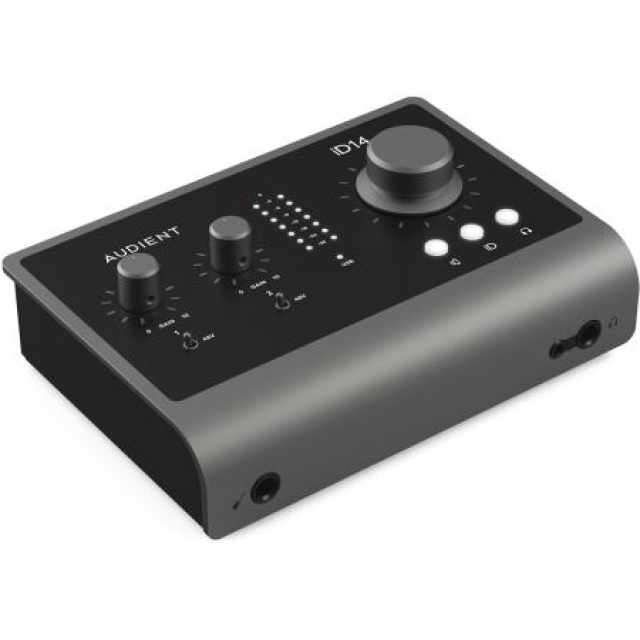
Why It's on the List:
- Console Microphone Preamp: Delivers professional, console-grade sound quality.
- Dual Headphone Outputs: Allows for shared listening or distinct mixes, supporting headphones up to 600 ohms.
- JFET Instrument Input: Provides a warm, tube-like sound with saturation for instruments.
- ScrollControl: Transforms the volume knob into a virtual scroll wheel for easy control of onscreen parameters.
- iOS Compatibility: Ensures you can record anywhere with your favorite iOS device.
- USB-C Connectivity: Offers bus-powered operation through a USB-C connection for convenience and portability.
Key Specifications:
- Bit Depth: High-resolution audio capture with support for up to 24-bit depth.
- Sample Rate: Supports sample rates up to 96 kHz, ensuring compatibility with professional recording standards.
- Latency: Features low-latency monitoring capabilities for real-time performance and monitoring.
- Inputs/Outputs:
- 2 analog inputs: 1 line in balanced (XLR), 1 microphone input (XLR), 1 Hi-Z instrument input (6.3 mm TS jack)
- 2 analog outputs: 1 line out balanced (6.3 mm TRS jack), 1 headphone output (jack or mini-jack)
- Phantom Power: +48 V phantom power supports condenser microphones for high-quality vocal recordings.
- Dynamic Range: Not specified, but known for Audient's high-quality, low-noise design.
- Signal-to-Noise Ratio (SNR): Ensures pristine audio capture with minimal background noise.
- Total Harmonic Distortion (THD): Low THD for pure and uncolored audio output.
User Reviews:
Music Radar commends the Audient iD4 mkII for its exceptional sound quality, high-quality components, and performance that surpasses competitors. Users appreciate the Legacy 4K feature for adding life to dull recordings and the detailed and nuanced capture of the class-leading preamps. The iD4 mkII is celebrated for bringing professional studio quality to personal workspaces, making it a top choice for both beginners and seasoned professionals looking to capture high-quality sound in their recordings.
Zoom H4n Pro
The Zoom H4n Pro is the gold standard in portable recording equipment. This recorder is suitable for a wide range of applications, from capturing audio for films and recording concerts to podcasts, interviews, sound design, and more. With high-quality microphone amplifiers, recording and playback resolutions up to 24-bit/96kHz, and a renewed noise gate, the H4n Pro Black offers clear recordings with less noise than ever before. This model has build in microphones, but it can also be used as a sound card with XLR and audio jack inputs. Priced around €200.

Why It's on the List:
- High-Quality Recording: Low-noise and crystal-clear recording quality.
- Super Stereo: X/Y stereo recording with adjustable angles for a wide or narrow recording zone.
- Simultaneous Four-Track Recording: For flexible recording options.
- Integrated X/Y Stereo Microphones: Adjustable between 90° and 120° for optimal recording settings.
- Phantom Power: +24 or +48 V for the main inputs and plug-in power via the mic/line minijack.
Key Specifications:
- Bit Depth: Up to 24 bits for detailed and dynamic recordings.
- Sample Rate: Supports up to 96 kHz, for clear and accurate audio.
- Latency: Designed for low latency during recordings.
- Inputs/Outputs:
- 2 microphone/line inputs with combined XLR/TRS connectors.
- Stereo 1/8" Mic In minijack.
- Phantom Power: +24 or +48 V for the main inputs and plug-in power via the mic/line minijack.
- Dynamic Range: Excellent dynamic range for clear recordings.
- Signal-to-Noise Ratio (SNR): High SNR for clean audio recording.
- Total Harmonic Distortion (THD): Low THD for pure and uncolored audio output.
User Reviews:
The Zoom H4n Pro Black is praised for its versatility, excellent sound quality, and the ability to perform in various situations. Users appreciate the built-in X/Y stereo microphones for their flexibility and the ability to record high SPL sounds without distortion. The portability and robust build quality make it a reliable choice for field recordings. While some users find the price on the higher side, many consider the H4n Pro Black a valuable investment for professional-quality recordings.
In summary, the Zoom H4n Pro Black is a top choice for professionals and serious hobbyists in the world of audio recording, with unparalleled sound quality, real-time processing capabilities, and a solid build. Its advanced features and compatibility make it a versatile and powerful addition to any recording setup.
DBX 286s
The dbx® 286s is a comprehensive channel strip processor that offers a studio-quality microphone/instrument preamplifier alongside four processors that can be utilized independently or in any combination. It's designed to provide a pristine, noise-free signal path for vocals and instruments, bypassing the need for a mixer. Priced around €249.

Why It's on the List:
- Studio Quality Mic Preamp/Channel Strip Processor: Ensures a pristine signal path for recording.
- Classic dbx Compression: Accessible, high-quality compression to smooth out acoustic tracks or achieve that "in your face" vocal performance.
- Frequency Tunable De-Esser: Reduces sibilance and high-frequency distortion from vocals and instruments.
- Enhancer: Adds sparkle and crispness to high frequencies and fullness to vocals and bass instruments, cleaning up muddy low midrange frequencies.
- Program Adaptive Expander/Gate: Allows for subtle reduction of headphone leakage or radical gating of noisy guitar amps.
- Insert Jack: Enables external processor integration or signal routing to an external destination.
Key Specifications:
- Mic Preamp Connector: XLR Floating balanced, Pin 2 Hot.
- Mic Preamp Input Impedance: ~4.2kΩ.
- Mic Preamp Gain: 0dB to +60dB.
- Phantom Power: +48VDC, applied to XLR pins 2 and 3 through 6.81kΩ resistors.
- CMRR: >40dB, typically 55dB.
- Input Connectors (line): Floating balanced, TIP Hot.
- Input Impedance (line): 10kΩ unbalanced, 20kΩ balanced.
- Max Input (line): >+21dBu, balanced or unbalanced.
- Output Connectors: 1/4" Balanced/Unbalanced TRS Connectors.
- Output Impedance: 100Ω unbalanced, 200Ω balanced.
- Max Output: >+21dBu, >+20dBm (600Ω load).
- Frequency Response: 20Hz to 20kHz, +0.5, -0.5dB.
- THD: <0.08%THD, 20Hz-20kHz, +10dBu, all Processing Controls OFF.
User Reviews:
The dbx 286s is celebrated for its ability to deliver studio-quality sound for both vocals and instruments. Users appreciate the flexibility of the four processors, which allow for a wide range of sound shaping and noise reduction capabilities. The classic dbx compression is noted for its effectiveness in smoothing out tracks and achieving professional vocal performances. The frequency tunable De-Esser and Enhancer are particularly valued for their ability to refine the sound quality of recordings. The inclusion of an insert jack for external processor integration is also a highly praised feature.
In summary, the dbx 286s is a highly recommended tool for studio recording, offering a range of processing capabilities in a single unit. Its studio-quality mic preamp, classic dbx compression, and additional processors make it a versatile and valuable addition to any recording setup.
M-Audio M-Track Duo
The M-Audio M-Track Duo is a compact and versatile 2-channel USB recording interface, perfect for Mac, PC, and iOS devices. It offers 48 kHz audio resolution in a portable format, ideal for music creation anywhere. With two Combo Crystal Preamps and phantom power, it's compatible with any microphone, making it a great choice for recording any sound source. Priced around €55.
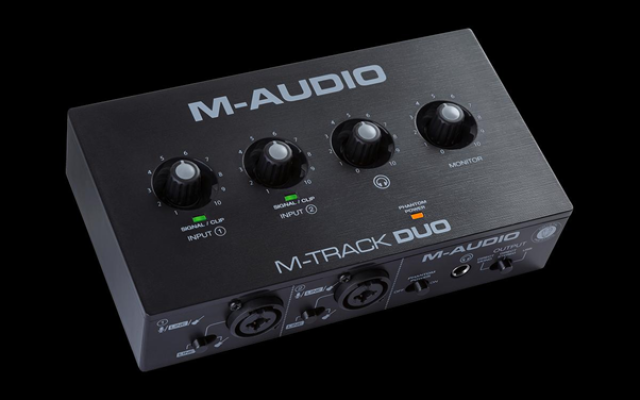
Why It's on the List:
- Crystal Clear Audio: Delivers 48 kHz audio resolution in a compact format for Mac, PC, or iOS devices.
- Versatile Inputs: Features two Combo inputs with dedicated switches for microphones, instruments, or line-level devices.
- Phantom Power: +48V phantom power for connecting studio condenser microphones.
- Direct Monitoring: Offers zero-latency monitoring with a USB/Direct switch for balancing direct inputs and computer playback.
- Software Bundle: Includes MPC Beats, AIR Music Tech plugins, and Revalver guitar amp plugin for immediate music production.
Key Specifications:
- Bit Depth: 24-bit (assumed based on industry standards)
- Sample Rate: Up to 48 kHz
- Latency: Zero-latency monitoring feature
- Inputs/Outputs:
- Mic Inputs: 2 Combo inputs with Crystal Preamps
- Line Inputs: Part of the Combo inputs
- Instrument Inputs: Part of the Combo inputs
- Main Outputs: Stereo 1/4” outs
- Headphone Output: 1/4” with independent level controls
- Phantom Power: +48V
- Dynamic Range: High (exact value not specified)
- Signal-to-Noise Ratio (SNR):
- Mic Input: 109 dB (A-weighted)
- Main Outputs: 109 dB (A-weighted)
- Headphone Output: 100 dB (A-weighted)
- Total Harmonic Distortion (THD):
- Mic Input: 0.003%
- Line Input: 0.002%
- Instrument Input: 0.005%
- Main Outputs: 0.002%
- Headphone Output: 0.02%
User Reviews:
The M-Audio M-Track Duo is praised for its portability, ease of use, and the quality of its preamps. Users appreciate the zero-latency monitoring and the comprehensive software bundle that comes with it, making it an excellent choice for beginners and experienced users alike. However, some users have reported compatibility issues with certain DAWs and a complex software download process. Despite these challenges, the M-Track Duo is recommended for its value and performance in home studios and for mobile recording setups.
In summary, the M-Audio M-Track Duo stands out for its portability, audio quality, and versatility, making it a top choice for music producers, podcasters, and musicians looking for a reliable recording interface. Its combination of high-quality preamps, direct monitoring, and a generous software bundle offers great value for anyone looking to start recording immediately.
Apogee Duet 3 Mobile Audio Interface
The Apogee Duet 3 is a sleek and powerful mobile audio interface that combines Apogee's legendary sound quality with onboard DSP for total mobility. Designed to seamlessly integrate with your MacBook, the Duet 3 brings DSP, portability, and Apogee's renowned audio quality into a stunning aluminum and glass enclosure. Priced around €650.
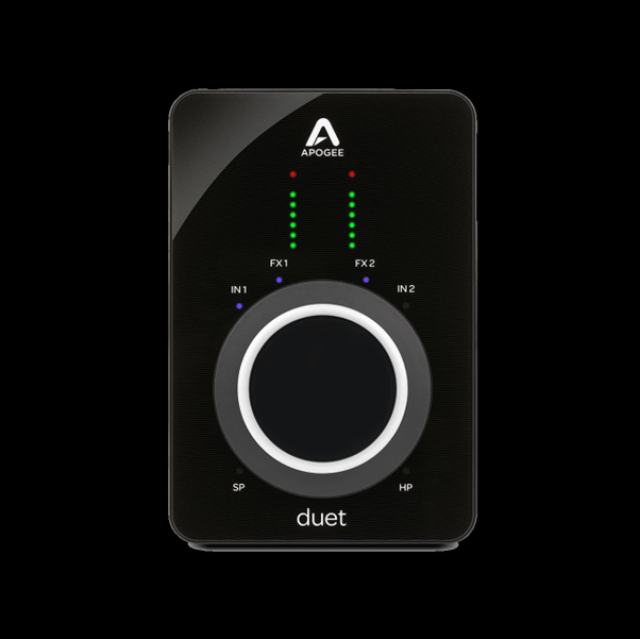
Why It's on the List:
- Legendary Sound Quality: Apogee's reputation for superior sound is unmatched, with a history of products used by Grammy and Oscar-winning artists.
- Onboard DSP: Features like the Symphony ECS Channel Strip, tuned by Bob Clearmountain, allow for latency-free monitoring and DSP processing directly on the device.
- Compact and Portable: With its low-profile design and aluminum body, the Duet 3 is built for on-the-go musicians and producers.
- High-Resolution Audio: Supports up to 24-bit/192kHz recording, ensuring your recordings are crystal clear.
- Versatile Connectivity: Offers two inputs and four outputs, including two world-class preamps and converters, instrument inputs, and balanced outputs.
Key Specifications:
- Bit Depth: Up to 24-bit
- Sample Rate: Up to 192 kHz
- Latency: Low-latency monitoring with DSP mixer
- Inputs/Outputs:
- Mic Inputs: 2 x XLR/line combo inputs
- Instrument Inputs: 2 x ¼” instrument inputs
- Main Outputs: 2 x ¼” balanced outputs
- Headphone Output: 1 x ¼” output
- Phantom Power: Yes, for connecting studio condenser microphones
- Dynamic Range: A/D conversion 122dB (A-weighted), D/A conversion 125dB (A-weighted)
- Signal-to-Noise Ratio (SNR): Mic Pre SNR 128dB (un-weighted)
- Total Harmonic Distortion (THD): A/D conversion -101dB, D/A conversion -110dB
User Reviews:
The Apogee Duet 3 is celebrated for its pristine audio quality, robust build, and the unique DSP capabilities that offer latency-free recording. Users appreciate the seamless integration with MacBooks and the intuitive Apogee Control 2 software that provides comprehensive control over the interface's features. The Symphony ECS Channel Strip is particularly praised for its ability to deliver professional-grade EQ, compression, and saturation without taxing the computer's CPU. While the Duet 3 is on the higher end of the price spectrum, users consider it a worthwhile investment for its performance, durability, and the quality of recordings it produces.
In summary, the Apogee Duet 3 is a top choice for professionals and serious enthusiasts in music production, offering unparalleled sound quality, onboard DSP capabilities, and a sleek design. Its advanced features and compatibility with Mac and PC make it a versatile and powerful addition to any studio setup.
Incorporating solutions for voice-over work
When choosing an audio interface or sound card for voice-over recording, consider how well it addresses latency and supports direct monitoring. An interface that excels in these areas will enhance your recording process, allowing you to deliver high-quality voice-overs with ease and confidence.
Understanding the implications of latency and the benefits of direct monitoring will equip you to select an audio interface that meets the demands of professional voice-over recording, ensuring your recordings are both high-quality and free from technical distractions.
Conclusion
In the intricate dance of voice recording, the sound card or audio interface plays a pivotal role, acting as the bridge between the raw, unfiltered essence of your voice and the digital realm where it finds its audience. As we've navigated the diverse spectrum of USB audio interfaces, from the sleek and simple to the feature-rich powerhouses, a singular truth has crystallized: the ideal interface transforms your voice-over work from the mundane to the mesmerizing.
Whether you're stepping into the voice-over world for the first time, a voice talent on the rise, or a seasoned narrator, the choice of your audio interface is a critical decision. It's not merely about the specs or the price tag; it's about finding a companion that resonates with your unique voice and the stories you wish to tell. In an era where technology leaps forward with each passing day, the core mission of the audio interface remains unchanged - to faithfully convey every shade of emotion, every subtle inflection, and every powerful pause of your voice.
Choose with care, for the right interface not only captures your voice but amplifies your identity. Let it be the foundation upon which your voice talent flourishes, reaching out and touching hearts, one recording at a time.
FAQ: Audio Interfaces and Sound Cards for Voice Recording
What does an audio interface or sound card do? An audio interface or sound card processes audio data between your computer and external devices like microphones and instruments. Audio interfaces, typically external devices, offer superior preamps and converters for professional-quality recordings. Sound cards, often internal, handle basic audio processing but may not offer the same quality or connectivity as audio interfaces.
Do I really need an audio interface or sound card? For professional voice recording and music production, an audio interface is essential for high-quality results. While standard PC sound cards can handle basic audio tasks, they lack the quality and features needed for professional work.
Do audio interfaces or sound cards improve sound quality? Yes. Audio interfaces significantly enhance recording quality with better preamps and converters. High-quality sound cards can also improve playback quality but may not match the recording capabilities of dedicated audio interfaces.
What do you plug into an audio interface or sound card? Microphones, instruments, and line-level devices can be connected to an audio interface for recording. Sound cards primarily handle playback and basic recording needs.
Which device offers the best audio quality? Audio interfaces generally offer superior audio quality for recording, with brands like Focusrite, Universal Audio, and Apogee being top choices. For playback, high-end sound cards from Creative and ASUS can enhance audio quality.
Do better devices make a difference? Yes. Higher-end audio interfaces provide better preamps, lower noise floors, and higher sample rates, all contributing to superior recording quality. For playback, a high-quality sound card can offer improved audio fidelity.
Are audio interfaces or sound cards worth it? For anyone serious about music production or voice recording, audio interfaces are a worthwhile investment for their superior recording quality. Sound cards can enhance playback quality but may not be necessary for professional recording tasks.
Compatibility and Requirements:
- iOS and Computer Compatibility: Most audio interfaces support macOS, Windows, and often iOS devices for versatile recording setups. Sound cards are typically designed for desktop PCs.
- MIDI Connectivity: Some audio interfaces and sound cards include MIDI connections for older keyboards and electronic instruments.
- Software Compatibility: Ensure your device is compatible with your preferred digital audio workstation (DAW) software and offers the necessary drivers for optimal performance.
Choosing Between an USB Audio Interface and a Sound Card:
- For Voice Recording and Music Production: An external audio interface is recommended for its high-quality preamps, converters, and versatile connectivity options.
- For General Audio Playback and Basic Recording: A sound card may suffice, but for professional-quality recordings, an audio interface is essential.
Investment Consideration: Investing in a high-quality audio interface is crucial for professional voice recording and music production, offering significant improvements in sound quality and recording capabilities over standard sound cards.
Written by: Loïc Thaler

Loïc
Male, Belgium
Urban, Warm, Reliable
- English (International)
- Within 4 hours
- From US$ 289,95